4. His Beatitude arrived at the Saint Louis airport on February 13 accompanied by Their Excellencies Roland Abou-Jaoude, Patriarchal Vicar General, Francis Baysari of Diman, Bechara Rai of Byblos, Mounjed Al Hachem of Baalbeck, Youssef Bechara of Antelias, Raymond Eid of Damascus, George Sader of Tyre, Tanios Khoury of Sidon, Fouad El-Haje of Tripoli, Paul Mattar of Beirut, and Chokrallah Harb (retired).
5. The delegation was received by His Excellency Justin Rigali, Bishop of the Archdiocese of Saint Louis, Bishop-elect Robert Shaheen, Bishop John Chedid of Los Angeles, Bishop Stephen Hector Douiehi of New York, Archbishop Francis Zayek (retired), Bishop Joseph Koury of Canada, and a large number of faithful.
6. Local and international reporters joined television and press corps from Lebanon (The Lebanese Broadcast Corporation International (LBCI), MTV, and AnNahar Newspaper) in covering the Patriarch’s historic visit.
III. The Ordination [i]
7. On February 15, 2001, a most historical celebration took place at the Saint Louis Basilica. The grand cathedral was filled with Bishop-Elect Shaheen’s family, friends, parishioners, invited guests, and a great number of Maronites who came from all over the United States to welcome their Patriarch and to be witnesses on this great day. It was thrilling for them to witness one of their own elevated to the episcopate according to Eastern tradition.
8. The ordination ceremony included rituals which were rich in meaning, symbolism, tradition, and history. These included the laying on of hands, the anointing of head and hands, the enthronement on the bishop’s chair, and the presentation of the hand-cross, the pastoral staff, the clock, the ring and the Bible. |
|
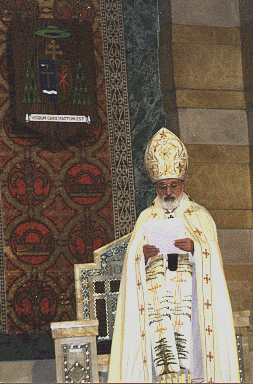
Patriarch Sfeir presiding over this historical event.
Photo by Micheline Tanios, curtsey of Al-Massira Magazine.
St. Louis, February 15, 2001.
|
9. The celebration began with the Lighting of the Church by the deacons and sub-deacons. At the same time, a choir of 75 men and women from the Maronite churches of Saint Raymond of Saint Louis, Missouri and Saint Sharbel of Peoria, Illinois, led the congregation in singing the Hymn of Light in Syriac and English. The Lighting of the Church proclaims Christ as the Light that shines upon the world, conquering darkness and death. As illumination in the Church increased, the beautiful mosaic walls reflected a shimmering multicolored glow whereby the saints and angels appeared almost to become alive and suspended between heaven and earth.
10. When the bearer of the Cross began the procession, people rose and turned to the foyer as the choir chanted the Entrance Hymn ‘Come in Peace’, announcing the entry of the priest into God’s house. When the procession advanced toward the alter, it passed the honor guard of the Order of Saint Sharbel while the choir sang ‘Here I Enter’.
11. Over three hundred priests, monks, deacons, sub-deacons, and more than 20 bishops marched through the church and took their places before Patriarch Sfeir reached the altar. Enrobed as a representative of Christ the King, the Patriarch entered wearing his patriarchal miter with the Cedar of Lebanon embroidered upon it, holding the shepherd’s staff, and as in the Eastern tradition carrying the hand-cross with which he blessed the congregation. Many people were in tears as they watched the majestic procession. |
12. After the singing of the Entrance Dialogue in Syriac at the foot of the altar, Bishop John Chedid welcomed everybody, naming specifically His Beatitude Patriarch Sfeir, His Eminence the Papal Nuncio Gabriel Montalvo, and Their Excellencies the Maronite, Latin and Greek Catholic (Melkite) Bishops.
13. After the Doxology, the Opening Prayer, the Greetings, the Hymn of Angels, the Prayer of Forgiveness (Hoosoyo), the Sedro, and the Qolo, the Patriarch prayed the Etro saying: “O Lord, in Your mercy, accept this incense offered before You at this moment. Send Your Holy Spirit to us and to Your servant, Robert, who awaits Your gifts. Thus, we give glory and honor to You, to Your Father, the treasure of blessings, and to Your Holy Spirit, the perfection of all gifts, now and for ever.”
14. Next, seminarian and choir director Andre Mhana intoned skillfully the Gospel in Arabic, followed by the reading of the Bible in English. The Patriarch’s homily concentrated on the biblical quotation “Go first and be reconciled with your brother” (Matthew 5:24).
15. The Divine Liturgy continued with the Pre-Anaphora when the patriarch approached the altar and awaited the Transfer of the Offerings. He prayed in Syriac “I will go to the altar of God”, followed by the Anaphora of the Twelve Apostles which is appropriate at the ordination of a bishop, a successor of the apostles. Before the Eucharistic prayer, the Patriarch and all the Bishops removed their Miters. Bishop Zayek, Bishops Douiehi and Chedid the current Bishops of New York and of Los Angeles, the Papal Nuncio, and the Bishop of Saint Louis joined the Patriarch at the altar for the Words of Institution which was sung in Syriac. For us who were present, it was an awesome moment to hear the same words again proclaimed in the language used by Christ nearly 2,000 years ago at the Last Supper.
16. After the consecration of the Eucharist, our awaiting the second coming of Christ is proclaimed: “Whenever you eat this bread and drink from this cup, you do so in memory of me until I come again.”
17. After the invocation of the Holy Spirit and the Intercessions, the choir and the congregation sang during Communion: one of the most profound prayers in the Maronite tradition. “You have united, O Lord, Your Divinity with our humanity and our humanity with Your Divinity; Your life with our mortality and our mortality with Your life. You have assumed what is ours, and You have given us what is Yours, for the life and salvation of our souls. To You, O Lord, be glory for ever”. Next, they sang: “Make us worthy, O Lord God, to sanctify our bodies with Your holy body and to purify our souls with Your forgiving blood. May our Communion be for the forgiveness of our sins and for eternal life. O Lord our God, to You be glory, for ever.” Here, the Patriarch and then all the bishops took communion while the choir and the congregation sang: “Hosts of Heaven stand with us at the altar”.
18. After his communion, Patriarch Sfeir was seated in the center of the altar area. He was wearing the Miter and holding the hand-cross in his right hand and his pastoral staff in his left. The Apostolic Nuncio read the Papal Bull, which contained the appointment of Monsignor Shaheen as a bishop. The Bishop-Elect then removed his Phaino (cope) and the rite of ordination began. |
19. Monsignor Shaheen then approached the Patriarch, knelt before him, kissed his ring, and asked for his blessing, saying in Syriac: “Give me your blessing, Father, Head of our Bishops.” The Patriarch responded: “May the Lord God bless you with His right hand and make you worthy of the Order of Bishop for which you were chosen. In the name of the Father and of the Son, and of the Holy Spirit.” The congregation answered: “Amen”.
20. By kneeling before the Patriarch, the Bishop-Elect “symbolized his unworthiness for the office to be assumed and his dependence upon God and the prayers of the Christian community.” The Patriarch then directed the Bishop-elect to recite the Profession of Faith, saying: “Beloved brother, profess the faith that you signed with your own hand.” The Bishop-elect proclaimed the following: |
|

Bishop Shaheen
Photo by Micheline Tanios, courtesy of Al-Massira Magazine.
St. Louis, February 15, 2001.
|
21. “I, Robert Shaheen, called by the grace of God and by the choice of the Syriac Antiochene Maronite Bishops’ Synod from the Order of Priesthood to the Order of Bishop of the Eparchy of Our Lady of Lebanon of Los Angeles, believe firmly in God the Holy Trinity: Father, Son, and Holy Spirit.
22. I believe in God the Father, who has no beginning or end. He created the universe by His Word and sustains it by His Might.
23. I believe in God the Son, the second Person of the Holy Trinity, begotten of the Father from all eternity and not made; He took flesh by the power of the Holy Spirit from the Virgin Mary and became man, like us in all things but sin. He guided us by the light of His gospel and redeemed us by His cross on which He shed His blood for us in redemption of our sins. He rose from the dead and poured forth for us the fountain of eternal life through the divine Mysteries of His Church, especially:
24. The Mystery of Baptism that enables us to become the adopted children of God;
25. The holy Myron (Chrism), by which the Holy Spirit empowers us to proclaim our Christian faith;
26. And the Mystery of the Eucharist, our food on our journey toward Him Who is seated at the right hand of His Father as our Intercessor in heaven.
27. I believe in the Holy Spirit, the third Person of the Holy Trinity, the Giver of life. He proceeds from the Father and the Son and has spoken through the prophets and apostles.
28. I acknowledge the first seven Ecumenical Councils:
29. The First Council of Nicaea (325 A.D.), which confirmed that the Son is of the same essence as the Father;
30. The First Council of Constantinople (381 A.D.), which confirmed that the Holy Spirit is of the same essence as the Father and the Son;
31. The Council of Ephesus (431 A.D.), which confirmed that the Son is both true God and true Man and that the Virgin Mary is the Mother of God;
32. The Council of Chalcedon (451 A.D.), which confirmed that in the Son there is one Person with two perfect natures, one divine and the other human;
33. The Second Council of Constantinople (537 A.D.), which clearly reaffirmed the teachings of the previous Ecumenical Councils;
34. The Third Council of Constantinople (681 A.D.), which confirmed that there are two wills in the Son, one divine and the other human, both in one Person;
35. And Second Council of Nicaea (787 A.D.), which established the veneration of the cross and icons of the Blessed Virgin Mary and the saints.
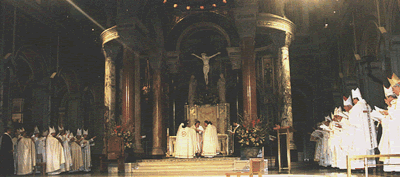
36. And I acknowledge the other Ecumenical Councils convened subsequently by the Holy, Catholic and Apostolic Church.
37. I acknowledge the Sacred Scriptures revealed in the Old and New Testaments.
38. I profess that the Lord Jesus Christ designated Peter as his successor and the head of his Church; and that Peter placed his See in Antioch first, then moved it to Rome where he was martyred for the love of Christ.
39. I acknowledge the successors of Peter, the great popes who presided over the Church and occupied the See of Rome. I acknowledge especially His Holiness Pope John Paul II. May God confirm his leadership.
40. I also acknowledge that the Maronite Patriarchs succeeded consecutively to the Antiochene See of Peter down to our Father, Patriarch Mar Nasrallah Peter Sfeir. May God assist him and grant him many years of leadership over us.
41. I pledge before God, before the altar and the Holy Mysteries, before the angels and saints, and before this community here present, to submit to them and to obey them and their successors with a filial obedience and to act according to their advice and their fatherly guidance.
42. I also pledge to endeavor, by the grace of God, to make every effort in directing the Eparchy entrusted to me, for the sanctification of souls, clergy and laity and especially the priests, my collaborators in my Episcopal mission.
43. This is my profession; I proclaim it freely; I signed it by my own hand. May God who is my Witness, help me to be committed to it.”
44. Monsignor Shaheen presented the signed Profession of Faith to the Patriarch, asked for his blessing and returned to his seat. Two bishops then came and led the Bishop-Elect to the Patriarch saying: “We present to your Beatitude, our pure Father Mar Nasrallah Peter Sfeir, our Patriarch, this God-loving servant, Robert. He is standing here to accept the imposition of the Divine Hand for the Order of Bishop of the Eparchy of Our Lady of Lebanon of Los Angeles. As he vows obedience to your Beatitude, we all pray for him, and proclaim three times: Lord have mercy.”
IV. The Rite of Imposition of the Hands
45. The congregation was deeply reverent when the Bishop-Elect knelt for Divine Grace in front of the Patriarch, who stood and removed his miter. Two co-consecrator Bishops placed the Book of the Gospels, opened to John 10, over the head of the Bishop-elect. They joined the Patriarch in placing their hands on the head of the Bishop elect and prayed calling upon the Holy Spirit to descend and bless him. The Patriarch then presented Bishop Shaheen with the Book of the Gospels, inscribed with the date of the ordination and the ordination certificate both signed by His Beatitude.
46. The ceremony of the placing of the hands resumed when the Patriarch placed his left hand on the Mysteries (the bread and wine) and his right hand on the head of the Bishop-elect and prayed again for the descent of the Holy Spirit. For the third prayer of the placing of the hands, the Patriarch was joined by all the attending bishops who raised their right hands toward the head of the Bishop-elect and declared together: “By the power of your Word, O Lord God, and through Your compassion, You have created all things. You established the universe by the will of Your Only Begotten One; You granted us the understanding of truth, revealed to us Your Holy Spirit, and gave us Your Beloved Son, the Word of God. By His outpouring of [shedding of His] blood, the Church and the rites of priesthood were founded. Now send Your Guiding Holy Spirit upon Your servant Robert, so that he may shepherd the Church, lead it, and ordain priests and deacons for it. He will consecrate altars and churches, bless the homes of the faithful, bind and loose, and confirm Your people and the sheep of Your flock, for You are the Giver of good works. To You, Lord God, be glory for ever.” The Deacon then proclaimed: “With glory and honor You crowned him and by the works of Your hands You empowered him.”
47. The Imposition of Hands is a pre-Christian tradition that was incorporated into Christianity. Placing the hands on another person is symbolic not only of transferring blessing but also of passing on authority and power. It is also to give the person a sacred character and to set him apart from the rest of the designated ministry. Saint Paul in his First letter to Timothy talked about the empowerment conferred by the imposition of the hands in Chapter 4 Verse 14, saying “Do not neglect the gift you have, which was conferred on you through the prophetic word with the imposition of hands of the presbyterate.” In Christianity, the imposition traces its power from the Holy Spirit Who came over the Apostles and the Blessed Mother in the Upper Room. This is recorded in the Acts of the Apostles, Chapter 2, as follow: “And suddenly there came from the sky a noise like a strong driving wind and it filled the entire house in which they were. Then there appeared to them tongues as of fire, which parted and came and rested on each one of them and they were all filled with the Holy Spirit.” Luke uses the placing of hands in many instances in his recording of the Bible to indicate that miraculous power or healing was conveyed (See Acts 5:12; 8:17-19; 9:12, 17; 14:3; and 19:6, 11).
V. The Rite of the Anointing with Myron (Chrism)
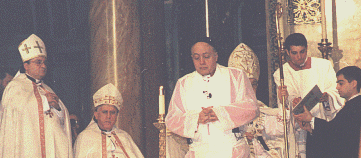
48. Following the placing of the hands, the Rite of the Anointing with the Myron (Chrism) began when the Bishop-Elect knelt again before the Patriarch who anointed his head with the Holy Myron, prayed, anointed the palms of the hands, joined them and prayed: “Grant him, O Lord, by this anointing the joy of Your Holy Spirit and empower him with that power You granted to Your Apostles so that he may offer sacrifices and offerings, distribute Your Divine Mysteries to the faithful, and walk before You with a living faith and pure heart all the days of his life.”
49. In the days of the Old Testament, prophets, priests, and kings were appointed by anointing their heads with special oil. The tradition continued in Christianity through the use of specially prepared oil called The Myron. By this ritual, the ordination is sealed and cannot be erased. It means that the thoughts and hands of the Bishop are marked by the Holy Spirit and are prepared for the sacred duties.
50. While the Patriarch and the Bishop-Elect washed their hands, the choir and the faithful sang “O Lord, protect Your Holy Church.” His Beatitude was then seated and proclaimed the ordination of the new Bishop.
VI. The Rite of the Enthronement
51. With the announcement, the ordination was concluded. Then began the Vesting and Handing Over of the Episcopal Insignia when the Patriarch pronounced: “Beloved brother, your ordination to the Order of Bishop is accomplished. Put on now the vestment and carry the Episcopal insignia, not for a perishable and worldly consideration, but for the greater glory of God and the up-building of the Holy Church.” The Patriarch then handed the new Bishop his cope, a pectoral cross, a ring and a Miter. As he handed him the staff, the Patriarch proclaimed: “The scepter of your power the Lord will stretch forth from Zion” (Ps 110:2). The choir then sang “Save Your people, and bless Your inheritance; shepherd them, and carry them forever.” (Ps 28:9).
52. The final rite was the Seating upon the Throne. The Patriarch directed the new Bishop to sit on the chair prepared for him saying: “Sit as a bishop on the chair of the Eparchy of Our Lady of Lebanon of Los Angeles in the name of the Father and of the Son and of the Holy Spirit.” The choir then proclaimed “He is most deserving and worthy.”
53. This ritual is figurative for it reflects the reign of the Kingdom of God, with Christ as the King. Because the Apostles and their successors, the Bishops, are the heirs of Jesus on earth, they are symbolically enthroned as leaders of their See to accomplish the Kingdom of God on Earth.
54. Next, there was the procession of the new bishop through the church accompanied by two bishops on either side of him. He carried the pastoral staff in his left hand and with the hand-cross in his right, blessed the people. The procession ended with a thanksgiving prayer by His Beatitude. Returning to his seat the new bishop received greetings from the bishops attending. Then the priests of his diocese came individually, knelt before him and kissed his ring as a sign of obedience.
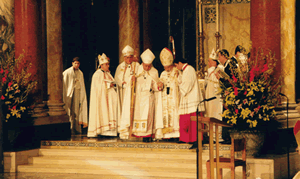
Patriarch Sfeir leads Bishop Shaheen to the people after the ordination and the enthronement ceremonies.
Photo by Micheline Tanios, curtsey of Al-Massira Magazine.
St. Louis, February 15, 2001.
55. The new Bishop proceeded to the altar to take communion followed by the priests, deacons, and the laity. The ordination then ended with the blessing, dismissal and “the prayer of farewell” to the altar. Bishop Shaheen then made his first public speech as a Bishop. He asked people to say a Hail Mary for him and to pray for the Patriarch and Lebanon.
56. The ordination and enthronement, which was attended by over 1500 people, lasted over three hours. People were absorbed in prayer and they were inspired by the music and the symbolic rituals. Although the whole ceremony was grand with the Patriarch presiding and more than twenty bishops attending it, there was an atmosphere of humility, mysticism and spirituality that cannot be conveyed in words. The choir sounded heavenly. The translation of Syriac prayers into English maintained an air and essence of the early centuries in the life of the ancient Eastern Church. There was complete harmony throughout the sacred multi-lingual ceremonies.
57. The ordination and enthronement As Bishop Shaheen assumes his responsibilities, we join Saint Ephrem the Hymnographer in praying for His Excellency, chanting “O you pastors, be made like unto that Diligent Pastor, Leader of the whole flock who cared so greatly for His flock. He brought near those who were afar. He brought back the wanderers. He visited the sick. He strengthened the weak. He bound up the broken.”
VII. Bishop Robert J. Shaheen’s Coat of Arms |
58. A coat of arms is a visual expression of one’s personal and professional life. By heraldic tradition, the personal arms of the Bishop of a Diocese -- the right side of the shield is joined with the arms of his Diocese -- the left side of the shield. |
|
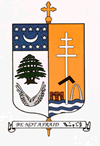
|
59. The ordination booklet describes Bishop Shaneen’s coat of arms as follows: “arms of the Diocese are composed of a white field on which the main symbol is the cedar of Lebanon, giving graphic representation to the title of the Diocese. This symbol is combined with, and placed below, a crescent and scattering of twelve stars against a blue background to honor the Blessed Virgin Mary, the titular of the Diocese, by calling to mind the description given to May in the Book of Revelation: “… a woman clothed with the sun, with the moon under her feet and on her head a crown of twelve stars” (Rev. 12:1). The twelve stars also have particular significance to the Maronite Church, for they express the Bishop’s status as a successor of the twelve apostles. Below the cedar is a pair of silver angel wings to signify that the seat of the Diocese is in los Angeles, the ‘city of Angels.’ For his personal arms, seen in the right side of the design, Bishop Shaheen has adopted a design that reflects the story of his ministry. Against a golden field stands a white Antionchene cross, closely associated with the Maronite Church and its Patriarchate. On the cross is placed a brown carpenter’s right angle, symbol of St. Joseph, a favorite patron saint of the bishop. On one side of the cross is a red stone bridge rising above the water, a design borrowed from the city of Bridgeport in Connecticut, the Diocesan seat of the bishop’s childhood home of Danbury. On the other side of the cross is a silver arch, also rising above the water, a symbol of the city of St. Louis in which the Bishop served as Pastor for thirty-four years prior to his Episcopal appointment. The blue and white waters below the cross recall the Mystic River of Connecticut and the Mississippi River of Missouri. Thus the symbols speak of the Bishop building up the Maronite Church from his origins in Connecticut to his ministry in St. Louis. For his motto, Bishop Shaheen has selected the phrase, “ Be Not Afraid,” written in English and in Syriac. These words, taken from the Gospel of St. Matthew (14:27), have been a constant refrain in the papacy of Pope John Paul II who appointed Bishop Shaheen, and express to us the Bishop’s firm faith in Jesus Christ. The device is completed with the external ornament of a gold processional cross.”
|
|
|